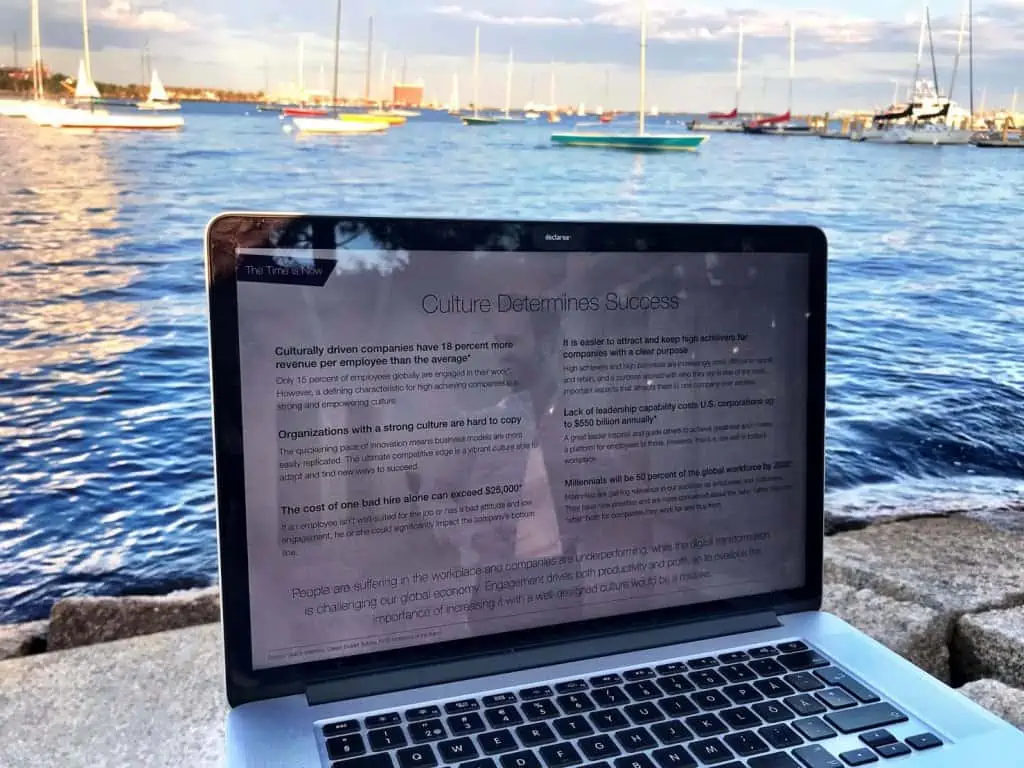“What gets measured gets done,” the old saying goes. With increasing numbers of employees now remote at least several days per week, attention to culture, and the sense of belonging and engagement that accompanies it, is increasingly essential. How will you do it?
More than 7 out of 10 people in a Slack survey said they prefer a combination of remote and in-person work to fully remote or entirely in-person once a return to the office was allowed, while another survey showed 39% of U.S. adults “would consider quitting if employers weren’t more flexible about remote work.” Cue the scare quotes around “The Great Resignation.”
This loss of the shared office experience brings with it a host of opportunities and challenges. One of those central challenges is cultural. How do companies nurture fulfillment, engagement, and a sense of belonging, when there is no physical place and limited social gathering to help people feel like part of a team?
The answer to this question involves multiple aspects. Fine-tuning your culture with an eye towards creating an outstanding employee experience is a challenging and multi-faceted process. But it’s a process that increases engagement, morale, and performance if done correctly.
For example, one of the key pieces of a thriving culture is a sense of belonging. Understandably, productivity and results tend to be the primary focus when thinking about culture, but our experience has shown a sense of belonging to drive both. The more people feel aligned with the values of their organization, the higher they score on intrinsic and extrinsic measures of job satisfaction and career success. This is even more relevant in the world of remote work. Effective teamwork, creativity, trust—these are all key metrics when focusing on culture; each is deeply connected to belonging.
Critically, for a company to foster belonging and an outstanding employee experience all around, it needs to consider culture holistically, not just as a loosely connected set of recommendations and practices. This does not come easily, which is why we champion and work with leaders to develop annual Cultural Plans, focusing on belonging and engagement, to accompany annual strategic plans.

Intentionally Building a Culture
A 2012 study showed that 94% of executives believed a distinct company culture was important to business success. Yet a 2018 report revealed that fewer than 1 in 4 U.S. employees “strongly agreed” that they could apply their organization’s values to their work every day. This suggests a significant disconnect between leaders’ intentions and organizational execution. Although most would agree that culture is critical, for many organizations, that idea is not translated into concrete actions and strategies.
Companies with unplanned cultures will often have a quite pleasant, generic value statement, but provide little concrete direction for connecting these values to desired behaviors, goals, and achievements. For the more dysfunctional organizations, culture surfaces only in trying times, when urgent intervention is needed — or when referencing a written value becomes cover for poor behavior. Moments of crisis are not a good time to begin cultural work.
The strategic planning process offers a compelling comparison. The impact of strategic planning —and the outsized results of doing it right— makes this process a priority for leaders, especially at the beginning of a new year. However, we have encountered few companies who treat culture with the same rigor and routine.
How, then, does culture fit in with strategic planning?
As we just started the new year, this is an ideal time to look at where your culture is — and where you would like it to be. Integrating cultural and strategic planning will give you the chance to have yearly, quarterly or monthly check-ins where you can assess the pulse of your culture, and make sure you are living and breathing the essence of your culture daily.
Introducing the Cultural Plan
In our experience, which covers multiple decades and 30,000 company cultures worldwide, we have found executives often express uncertainty on where to start with culture. From a practical perspective, the first steps to a well-designed culture involve building a strong foundation and later creating initiatives to nurture it and enhance it. One of the many reasons for connecting your Strategic Plan with your culture is to align how you are achieving your goals through culture. But to know where and how to aim and to invest, many leaders require a more thorough approach that acknowledges the complexities of their organizations. This is why we created the Cultural Plan.
What does a Cultural Plan look like? Developing one that is data-driven and process-oriented—yet deeply people and purpose-centric—entails a multi-step process.
1. Cultural Foundation
As the name suggests, the Cultural Foundation is the cornerstone for everything you do in the company. It is the lens through which you will be creating the rest of your Cultural Plan. Your Cultural Foundation consists of four pillars: your purpose, your mission, your vision, and your values.
It is essential to keep in mind that culture isn’t just a nice thing to add but the main way to drive behaviors. By keeping your culture as your North Star, you will be able to design and create the behaviors you want your team to embody throughout the company.
2. Defining Success: Growth Forward
When you embark on a journey, it is essential to know where you are going. You know you want to succeed and have a thriving year, but what does that actually look and feel like? The first step is defining the meaning of success and finding alignment between all parties involved.
One way of doing this is by breaking down your business into its different strategic areas and defining success in each of them. For example, a possible classification is:
- Financial: Tripling your ARR (annual recurring revenue).
- Customer Experience: Achieving an average of 9.8 in NPS (net promoter score).
- Culture: Having 95% of your company made up of High Performers.
- People: Achieving an average score of 9 of 10 in employee engagement.
These definitions can be framed in connection to both your Strategic Plan and your Cultural Plan simultaneously. After defining your idea of success, it is also important to lay down the implications: if you achieved this, what would it mean to the company?
3. Defining Success With a Cultural Focus
Like most companies, you probably have a definition of success involving aspects like product development, revenue, and customer satisfaction. But what does success mean when it comes to your people and your culture? What does your dream culture look and feel like?
One way of defining your cultural North Star is by creating a short statement that captures the essence of your culture. Since this should be in direct alignment with the values of your company, it is unique to each organization. If you described your culture through a combination of your values, what would that look like?
For example, a cultural North Star could be: “A culture where people achieve greatness together on a daily basis and where everybody is thrilled to show up and contribute their best.”
Determining your cultural North Star will be the key to designing your goals and how you are going to achieve them.
Goals for Culture
Just like the goals in different areas of your company, cultural goals should be concrete and measurable. Committing to goals that help you strive for your cultural North Star is the first step to designing a path towards achievement that integrates the things that matter the most to you.
One way of doing this is by taking each of your values and connecting them to a behavior that you want to celebrate and encourage in your team members. Here are some examples of what that could look like: If you want to drive the value of “making others successful,” your goal can be that your team members show appreciation to each other. This can be achieved through different means, as it is important to express appreciation in the ways that resonate the most with others.
If you want to drive the value of “lifelong learning,” your goal can be connected to the learning initiatives you invest in during the year. This can include training and coaching programs, leadership initiatives, and weekly activities like workshops and skill development programs. When you achieve your cultural goals, celebrating them with the entire team is also a great way of keeping the momentum going.
4. Cultural Audit: Starting Point
After you know where you want to go, you need to assess where you are starting out. The Cultural Audit is a multi-layered process that allows leaders to understand the current state of their culture, with a concrete, qualitative analysis that includes every aspect, from cultural alignment and engagement in every level of the company, to how your culture is showing up in everyday life of the company, and what initiatives you have in place to ensure scalability.
The Cultural Audit studies your culture in three main areas: Foundation, Strength, and Scalability. The result is a thorough blueprint that reveals the pain points, the development areas, and the opportunities in your culture. For a deep-dive into the Cultural Audit, click here.
5. Key Initiatives and Priorities
Cultural initiatives at different levels help keep your culture thriving while growing. What initiatives will you prioritize throughout the year to nurture your culture and strengthen your team members’ engagement and connection to it?
There are multiple initiatives that can level up your culture. Retreats bring everyone in the company together to truly experience your culture while creating peak memories and strengthening their bonds with each other. Management offsites —which can occur on a quarterly or bi-yearly basis— reunite the c-suite from different locations to rally around a specific initiative or primary goals for the year, ensuring everyone is aligned and laser-focused. Different weekly activities can serve your team members by focusing on specific company values, strengthening areas like mindfulness, productivity, connection, and creativity. Weekly initiatives can include guided meditations, workshops, and skill development programs like RemoteEx. Access to online learning opportunities is a valuable way of investing in your people’s development and encouraging lifelong learning. Customized leadership programs like LeadEx can help level up your internal leaders, elevating your entire culture. Peer-to-peer-facilitated training programs serve to develop different skillsets in your team members, which can include design thinking, presentation skills, and negotiation skills. Office hours with internal leaders and external experts can be very valuable to your high-performing team members. Full-day events that bring people together with a purpose, like planning, brainstorming, or achieving specific goals, can be a great way of engaging your team around performance and a sense of achievement.
6. Key Metrics and Drivers
How are you measuring the culture you want to achieve? Just like you have financial metrics and growth metrics, to keep culture actionable and scalable, it is important to select a set of metrics that reflect your values and the behaviors you want to drive and celebrate. This will allow you to assess in a tangible way how you are living out your values as achievements.
In the section Goals for Culture, you connected your values to the behaviors you want to drive in your team members. If this is your first time doing this exercise, you can also start with three main areas. An example: leadership, collaboration, and communication.
The next step is designing a way of measuring your team’s performance in connection to each specific value. Let’s see what this can look like.
- Area: Collaboration
- Value: Making others successful
- Metrics: Amount of expressions of appreciation per week. Amount of interactions with the purpose of supporting others per week.
A way of adding value to the initiative is by celebrating the team members who contribute the most to these goals (in the example, the one who gives the most recognition of appreciation and support.) This can be done on a weekly or monthly basis. A yearly internal awards ceremony is also a great way of celebrating your high-performing team members in alignment with your values, while keeping your people engaged and excited by highlighting their wins.
Experiencing the Magic of Cultural Design
Culture can be designed, but it takes the decision to design it and to design it well. Culture impacts everything from productivity, engagement, and customer loyalty, to the speed of innovation, retention of talent, growth, and, of course, profitability.
Although a Cultural Plan can be done at any time of the year, its effectiveness is increased when implemented in tandem with your Strategic Planning for the upcoming year. In an ever-changing environment, where hybrid and remote models are progressively becoming the standard, it is more important than ever to prioritize investing in designing a thriving culture for both short- and long-term success.



